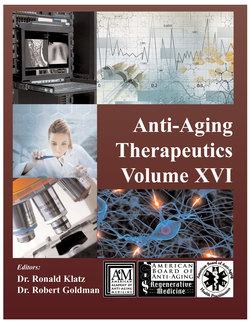Читать книгу Anti-Aging Therapeutics Volume XVI - A4M American Academy - Страница 36
На сайте Литреса книга снята с продажи.
DISCUSSION
ОглавлениеOur data show significant correlations with menopause symptomatology in a cohort of females ranging in age from 43 to 87-years, prior to taking estrogen. These hormonal correlations include DHEA associated with genitourinary; testosterone with all symptoms; FSH with pulmonary; TSH with both pulmonary and gynecological; estrone with musculoskeletal; and pregnenolone with both immunological and genitourinary. While we attempted to obtain data on a follow-up questionnaire only 13 patients responded following a mailed survey. Although this provided us with a small number for subsequent statistical analysis we did find significant correlations with FSH and immunological and dermatological symptoms as well as pregnenolone with immunological symptoms in this population. When we utilized a Bonferroni correction for multiple comparisons, none of these correlations were significant except for TSH, which correlated at r = .52 (p<.0001) with the pulmonary domain. We are confident that the significant correlations have clinical relevance because the Bonferroni correction was at a very conservative level at p< 0.0045.
Most interestingly, our results using factor analysis identified important symptom clusters with both somatic and neurological associations. In terms of the somatic symptoms (Fig. 1) pregnenolone was significantly associated at the p < 0.019 level. Our finding related to TSH correlating significantly with both neurological and musculoskeletal symptoms is in agreement with the work of Cakir et al.20 They demonstrated that musculoskeletal disorders often accompany thyroid dysfunction. In addition to the well-known observation that these disorders are common in patients with hypothyroidism, they are also observed in patients with thyrotoxicosis. The fact that we found an increase in TSH levels during menopause may be evident of a defensive mechanism by which the body is attempting to protect the menopausal female from aches and pains associated with musculoskeletal complaints. Moreover, during menopause high levels of TSH are related to vasomotor complaints.21 In addition, our finding of increased levels of LH and its association with the neuropsychiatric symptom cluster is in agreement with the work of Bowen,22 showing that elevated LH expression colocalizers with neurons vulnerable to Alzheimer’s disease pathology. LH agonists are known to affect 3 primary sites within the skeletal muscle, namely androgen receptors, the neuromuscular junction, and the second messenger systems, which includes insulin-like growth factor (IGF)-1. All sites have been demonstrated to lead to a decrease in isokinetic exercise strength in large muscle groups.23 The clustering of FSH with the musculoskeletal domain is not surprising since it has been shown that FSH levels increase during isokinetic resistance to exercise.24 Our finding of DHEA association with the immunological symptom cluster is in agreement with the recent review of Hazeldine et al,25 which correctly pointed out that DHEA secretion declines with age, a phenomenon referred to as the “adrenopause”. There are now many studies suggesting that DHEA plays a role in regulating human immunity, concurring with our factor analysis data. In agreement with our factor analysis, increased serum free testosterone concentration predicts memory performance and cognitive status in the elderly.26 Elevated free testosterone levels in women are associated with acne.27 This is in agreement with our finding that free testosterone is associated with the dermatologic symptom cluster. Finally, it is well established that total testosterone is responsible for depressing macrophage immune function after soft tissue hemorrhagic shock, a finding related to human regulation of immunity.28
It is noteworthy that ovarian activity is controlled by a “biological clock” in the hypothalamus. This controls the pituitary by a gonadotropin-releasing hormone. In response the pituitary secretes FSH and LH. Subsequently, the corpus luteum is created in the ovary, secreting progesterone while estrogen secretion continues. A cyclic drop in pituitary gonadotropin secretions causes the corpus luteum to degenerate. The ovary makes estrogen from cholesterol by converting it first to pregnenolone, then to progesterone, then to androstenedione and finally to estradiol. Estradiol is the estrogen secreted by the ovary, but it can be changed in the liver to estrone and estriol. The pathways of the steroid hormone synthesis are the same in the adrenal cortex. Furthermore, when estrogen deficiency occurs in menopause, LH levels increase. Later FSH rises and remains elevated for the rest of life. These raised FSH and low estrogen levels appear to be the causes of the characteristic hot flashes. Abrupt deprivation of estrogen causes more symptoms than a slow decline of function. Estrogen therapy may relieve these symptoms but not without adverse effects.29
Since the adjustment of tissues to an altered hormonal environment as a function of age may have impacted our findings, we decided to adjust for age as a co-variate. However, when we adjusted for age as a co-variate, we did not find any other significant differences. In follow-up research we will also access hormonal changes as a function of aging according to decades as a comparative analysis between premenopausal and postmenopausal females.
While our results are encouraging, we hope that larger studies will confirm these interesting findings. We believe that continued research in this area will ultimately provide a hormonal map which will inform the clinician as to what other specific hormones should be targeted besides estrogen. In fact, Mahmud1 has already suggested a multi-hormonal replacement approach using natural bioidentical products. By utilizing the factor analysis approach we are beginning to develop a number of hormonal clusters that map to menopause and will ultimately serve as a basis for our newly proposed bioidentical multi-hormone replacement therapy (MHRT).
